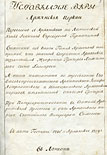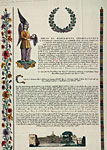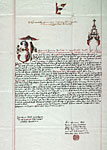Russian-Armenian Ecclesiastical Relations in the 18th - 19th centuries.
(from the Collections of the Manuscripts Department)
The exhibition
Monuments of the Armenian Culture in the National Library of Russia, held in 2010, was dedicated to 300th anniversary of the Armenian community in St. Petersburg and showed 12th-19th century Armenian manuscripts from collection of the Manuscripts Department of the NLR. The exposition of this year is devoted to ecclesiastical relations between Russia and Armenia in 18th-19th centuries. It is remarkable for its great attention to the documents reflecting the direct contacts of Russian and Armenian state and church leaders, as well as to the issues in studying the history and religion of the Armenian Apostolic (Gregorian) Church in Russia.
Official relations of the Armenian Church with the Russian state were established by Catholicos Simeon I Yerevantsi who sent the delegation with holy gifts (relics of St. John the Baptist, Noah's Ark, etc.) to Empress Catherine II. By the empress's decree dated June 30, 1768, the catholicos won the right of jurisdiction over all Armenians in Russia. In 1773, Simeon I appointed Archbishop Joseph Argutinsky-Dolgorukov (Hovsep Argutyan-Erkaynabazuk) the head of the Astrakhan diocese of the Armenian Church which included all Armenian communities on the territory of the Russia. Archbishop Joseph's pro-russian orientation and his vigorous political, ecclesiastical, social and educational activities contributed much to the establishment and strengthening of Russian-Armenian relations. In the letter dated January 31, 1782 to the member of the Holy Synod of the Russian Church Archbishop of Moscow and Kaluga Plato (Levshin), the Supreme Patriarch of all Armenians Luke I Karnetsi (1780-1799) expressed his gratitude for the hospitality extended to Archbishop Joseph by the Synod of the Russian Church. Two of Joseph's own documents have survived: these are a translation of the sermon preached by him on February 17, 1786 in the Armenian Church of the Assumption in Astrakhan, and a request letter to Senator A.B. Kurakin asking for a private meeting with Emperor Paul I. In 1799, Joseph was elected Patriarch of the Armenian people; and on June 28, 1800, this was approved by the emperor who had recently bestowed the princely dignity upon Argutinsky-Dolgorukov family, - Joseph, his two brothers and nephews.

In 1799, in St. Petersburg, the book
Christian Denomination of Armenian Church translated from Armenian into Russian and published in charge of Right Reverend Joseph, Archbishop of All Armenians in Russia, and Chevalier Prince Argutinsky-Dolgorukov. It includes: the Sacral Creed and Divine Liturgies (translated into Russian as early as 1740 by L.P. Zaleev), the Sacrament of Baptism in the Armenian Church, Creeds of Armenian Church. The National Library of Russia has a copy of the book signed by Prince David Argutinsky-Dolgorukov, the nephew of Patriarch Joseph, 'An Eager Gift to the Imperial Public Library from its Honorary Librarian, Prince Argutinsky-Dolgorukov. The Year of 1818, February 10.' This was one of the first books to introduce the Armenian Church Denomination to Russians. At the personal request of Patriarch Joseph, it was examined and edited by M.M. Speransky whom Joseph met in the house of the famous H. I. Lazarev. The history of the appearance and reissue of the book is illustrated by the two manuscripts:
Creeds of Armenian Church and
Christian Denomination of Armenian Church.
After the death of Patriarch Joseph, David V was elected Catholicos of the Holy See of St. Echmiadzin. His letter to Alexander I dated May 4, 1801 requested the emperor to recognize him the new catholicos.
During the Russian-Persian war of 1826-1828, the Eastern Armenia was liberated from Persian rule and annexed to Russia. A heroic page of this war is the battle of Oshakan. On August 17, 1827 a detachment under the command of Lieutenant-General A. Krasovsky thwarted an attack of the 30 thousand army of Persians on the Echmiadzin monastery and thus saved it from destruction. In the letter to A.I. Krasovsky dated March 15, 1828, Abbot of the monastery of Echmiadzin Catholicos Yeprem I reported on the presentation of a piece of wood from Noah's Ark in a small cross box to the General.
In 1836, Emperor Nicholas I approved the Code of Laws of the Armenian Church which regulated its activity in Russia. Appreciating the importance of this document as a new monument to the "spirit of tolerance" and Imperial patronage "to all peoples of other faiths living in Russia," on July 31, 1841, Catholicos John VIII (Hovhannes VIII) Karbetsi appealed to the monarch asking him to issue an imperial order not to print books or articles, regarding the Armenian Church, without the prior approval by higher spiritual authorities of this confession. "The reason for this was the publication of the book Supplement to the Proof of the Antiquity of the Tree-finger Sign of the Cross in the 1839. The publication contains, according to John VIII (Hovhannes VIII), unfair and offensive statements against the Armenian confession such as "Armenians share the false teaching of Arius." By order of the emperor, the Holy Synod gave appropriate instructions to the clerical censorship, and John VIII (Hovhannes VIII) was asked to deliver a detailed description of the faith of the Armenian Church to the Ministry of Internal Affairs. The memo A Brief Doctrine of the Armenian Church was presented by Nerses V elected Catholicos of the Holy See of St. Echmiadzin in 1843 after the death of John VIII (Hovhannes VIII). Along with the memo, Nerses V sent a copy of the book Historical Artefacts of the Armenian Church Creeds of the 12th Century published in St. Petersburg in 1847. In the letter to the Minister of Internal Affairs Count L.A. Perovski dated January 13, 1850, Nerses V stated that 'there is no other Armenian theological and historical book that examines the Armenian Church Creed with such clarity and distinctness like Patriarch Nerses' Conciliar Epistle and, especially, his correspondence to Emperor Manuel and Greek Patriarchs' included in the book. Translation of these documents into Russian language was made by one of the most prominent member of the Armenian community in St. Petersburg Alexander M. Khudobashev who served as Foreign College Chief Officer, and was a member of the St. Petersburg Main Archive. In order to acquaint Russians with the truths of faith and piety, as the Armenian Church understands them, Khudobashev translated the Preliminary Office of Betrothal and the Office of Crowning in Armenian Church into Russian.
At the same time, in the middle of the 19th century, there were published a number of works on the history and religion of the Armenian church by Russian authors: The Armenian-Gregorian Church (St. Petersburg, 1843) by the graduate of the Moscow Theological Academy, later Officer of the Ministry of Internal Affairs, N. Nadezhdin, the Review of the Ecclesiastic History of Armenians before the Fall of their Kingdom in 1375(1852) by K.I. Popov, A Brief Essay of the Armenian Gregorian Church (St. Petersburg, 1858) and the Liturgy of the Armenian Church (St. Petersburg, 1859) by the graduate of St. Petersburg Theological Academy Priest K. Dobronravin (later Bishop of Pskov Hermogenes) and others.
In the second half of the 19th century, valuable research studies on the history and religion of the Armenian Church appeared; these were works by the professors of the St. Petersburg Theological Academy Ivan Ye. Troitsky, and Vasily V. Bolotov. The first was the author of the book Creeds of Armenian Church written by Nerses, Catholicos Armenian, at the request of Pious Prince of Greeks Manuel, for which he was awarded the degree of Doctor of Divinity in 1875. He also made a translation of the Armenian Liturgy of St. Gregory contained in the second edition of the Collection of Ancient Liturgies. The eminent church historian and theologian V.V. Bolotov, a student of I.Ye. Troitsky, also devoted himself to the history of the Armenian Church. His lectures on the history of the ancient Church were translated into Armenian by Archimandrite Artak Smbatyants. Part of the translation was published by him in 1911 as a supplement to the journal "Ararat" (Echmiadzin).
In the 20th century, the study of the history of the Armenian Church has been continued.
Researcher of the Manuscripts Department
T. Bogdanova



